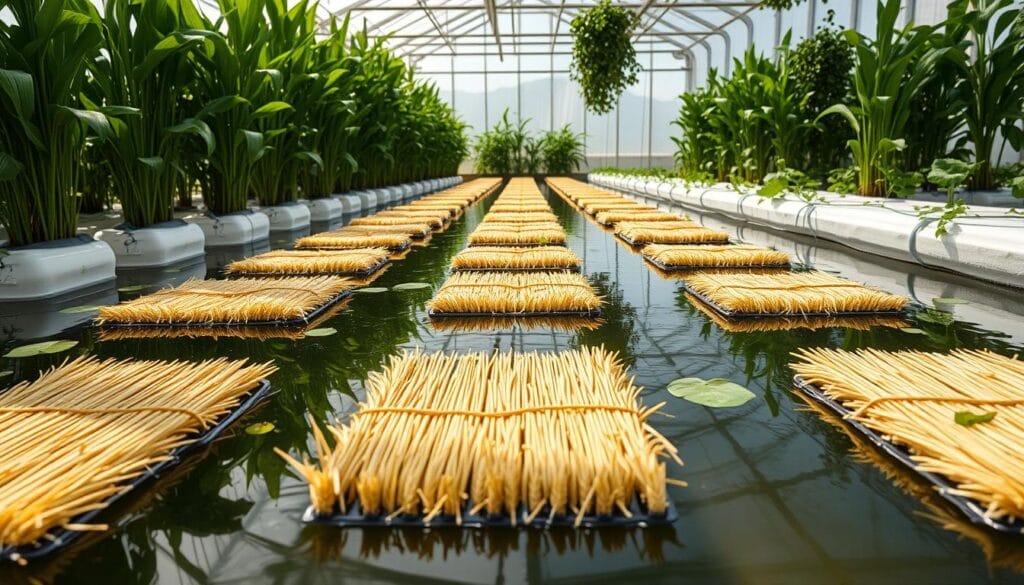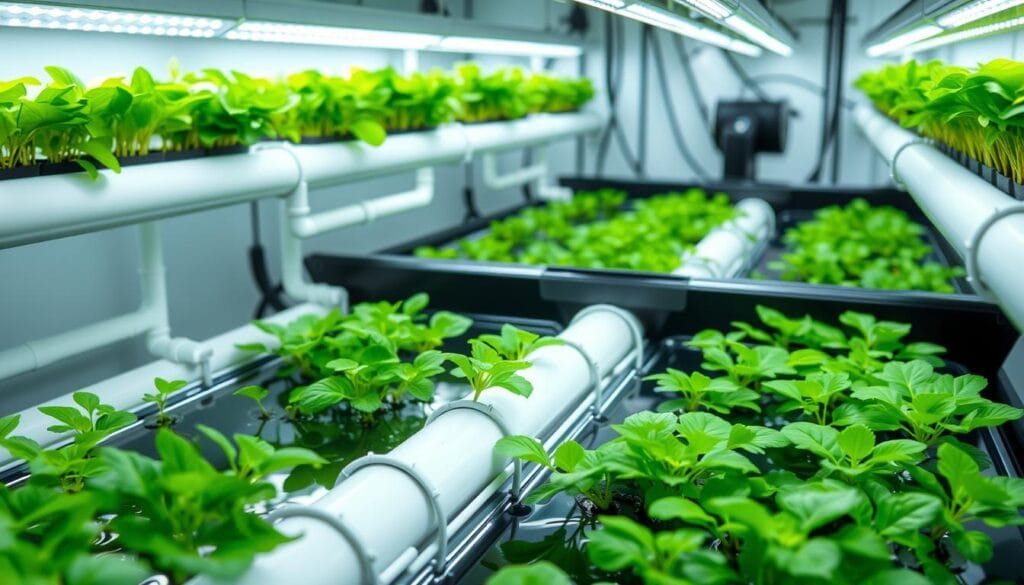Algae in hydroponics can be both beneficial and problematic. Certain algae contribute to system health and even produce up to 70% of the world’s oxygen, with additional uses in biomass and biofuel. However, excessive algae can lead to issues like oxygen depletion, nutrient competition with plants, and clogged systems. This article explores the causes of algae growth in hydroponics and offers tips for effective prevention and management.
Key Takeaways
- Algae can thrive in hydroponic systems due to the presence of light, nutrients, and suitable water conditions.
- Uncontrolled algae growth can lead to oxygen depletion, nutrient competition, and equipment clogging.
- Preventive measures include using opaque materials, chemical treatments, and biological control methods.
- Proper nutrient management, temperature control, and system maintenance are crucial for preventing algae infestations.
- Addressing algae growth promptly and implementing a multi-faceted approach are key to maintaining a healthy hydroponic system.
Introduction to Algae in Hydroponic Systems
Hydroponic gardening is a modern way to grow plants indoors without soil. It offers fast growth and high yields, but it also has challenges. One big issue is algae.
What is Algae and Its Significance
Algae are tiny, photosynthetic organisms that live in moist or aquatic environments. They are key in natural ecosystems by making oxygen and helping the food chain. But in hydroponics, algae are seen as pests because they take nutrients and light from plants, causing problems.
Algae as a Part of a Healthy Ecosystem
Algae might be a problem in hydroponics, but they’re important in nature. They feed many creatures, from tiny ones to big marine animals. Knowing algae’s role helps you manage them better in your garden.
Learning about algae in hydroponics helps you deal with their challenges. This way, you can keep your indoor garden healthy and productive.
Types of Algae Found in Hydroponic Systems
Hydroponic systems can face many types of algae. Each type has its own effects and needs to be managed well. Knowing about these algae helps keep your hydroponic setup healthy and productive.
Brown Algae
Brown algae, also known as seaweed, often appear in hydroponics. They can stick to surfaces, hiding harmful bacteria and blocking water flow. Also, their presence might show that the system’s pH or water quality needs adjusting.
Black Algae
Black algae are single-celled and thrive in bad water and pH issues. They can quickly spread, taking over and competing with plants for nutrients and light. This can lower the system’s overall output.
Green Algae
Green algae are common in freshwater hydroponics. They grow fast, competing with plants for light and nutrients. This can stunt plant growth and cut yields. It’s key to keep green algae in check for a healthy system.
Red Algae
Red algae are less common but still found in hydroponics. They can clog water flow and compete with plants for nutrients and light, just like other algae.
Bluish-Green Algae
Bluish-green algae mix green algae and cyanobacteria. They’re a big worry in hydroponics because they can release toxins. These toxins can harm or kill plants, posing a serious threat to the system’s health and productivity.
Managing algae effectively is vital for a thriving hydroponic system. Using preventive steps, chemical treatments, and biological controls can help. These methods can reduce algae risks and ensure your hydroponic project succeeds in the long run.
| Type of Algae | Characteristics | Impacts on Hydroponics |
|---|---|---|
| Brown Algae | Seaweed-like, can form biofilm | Harbors harmful bacteria, disrupts water flow |
| Black Algae | Single-celled, thrive in poor water quality | Competes with plants for nutrients and light |
| Green Algae | Most common in freshwater hydroponics | Competes with plants for light and nutrients |
| Red Algae | Less common, can cause clogs | Competes with plants for nutrients and light |
| Bluish-Green Algae | Combination of green algae and cyanobacteria | Releases toxins that can damage plants |
Causes of Algae Growth in Hydroponics
Algae growth in hydroponics comes from two main sources: algae spores and the right conditions for growth. Knowing these causes helps us prevent and control algae better.
Introduction of Algae Spores
Algae spores can get into hydroponic systems in many ways. This includes dirty equipment, contaminated water, or even from the air. Once they’re there, they can grow fast, causing algae to appear.
Favorable Growth Conditions
Hydroponic systems are great for algae because they have lots of nutrients, water, light, and the right temperature. The mix of nutrient-rich water and plenty of light makes algae grow quickly. This leads to big problems like algae blooms.
Things like causes of algae growth, algae spores, nutrient-rich water, light, and temperature are key to algae in hydroponics. Fixing these issues is the best way to stop algae in your hydroponic setup.
“Controlling algae growth is a critical aspect of maintaining a healthy and efficient hydroponic system.”
Algae in hydroponics and Its Impacts
Algae growth in hydroponics can harm plants and the system. It can deplete oxygen levels, stressing plants. Algae also compete with plants for nutrients, hurting growth and yields. Plus, it can clog equipment, disrupting the system’s function.
Microalgae can change water quality in hydroponics. Research shows that adding Chlorella vulgaris to vegetables can increase yields by up to 50%. Yet, more studies are needed to fully understand microalgae’s effects.
Using plant growth-promoting bacteria (PGPB) in hydroponics can boost plant growth. Actinomycetes, known for their growth-promoting abilities, are effective in hydroponics. They help increase crop yields through sustainable farming.
| Key Statistics | Value |
|---|---|
| Hydroponic market size in 2023 | Nearly $5 billion |
| Hydroponic market growth rate (CAGR) until 2030 | 12.4% |
| Top crops grown using hydroponics | Tomatoes, Herbs, Lettuce, Cucumber |
| Water usage reduction in hydroponics compared to traditional farming | Up to 90% |
| Productivity increase in hydroponics compared to soil-based farming | 2-5 times higher |
While hydroponics offer many benefits, algae growth is a significant issue. It’s important to manage and mitigate algae to ensure hydroponic success and sustainability.
Preventing Algae Growth in Hydroponic Systems
Keeping your hydroponic system healthy means fighting algae growth. Algae can mess with the nutrients your plants need. Luckily, there are ways to stop algae from taking over.
Using Opaque Materials and Managing Light
Algae love light, so cutting down on it is key. Use things like blackout curtains or hydroponic grow tents to block light. Also, make sure your plants get the right amount and type of light. This helps keep algae from growing.
Chemical Treatments
Chemicals can also help fight algae. Hydrogen peroxide or copper sulfate can kill algae. But, use these chemicals carefully and as directed to protect your plants.
Biological Control
For a natural way, add beneficial bacteria or other organisms. They compete with algae for resources. This method can keep algae under control for a long time.
By using opaque materials, managing light, treating with chemicals, and using biological control, you can prevent algae growth. This keeps your hydroponic system healthy and thriving.
Alternate Solutions for Algae Control
Managing algae in hydroponic systems is key. There are other ways to keep your system clean. These methods help gardeners and growers keep their hydroponic systems healthy and free of algae.
Barley Straw Rafts
Barley straw rafts are a good alternative. They contain compounds that stop algae growth. These rafts slowly release these chemicals, keeping algae away from your nutrient solution.
Grapefruit Seed Extract
Grapefruit seed extract is another option. It fights off fungi, bacteria, and parasites. Adding it to your system can get rid of algae and other harmful microorganisms, making your growing space cleaner and healthier.
UVC Light
UVC (ultraviolet-C) light is also effective against algae. It kills microorganisms by damaging their cells. But, it’s important to use it safely because it can harm humans if not handled properly.
Using these alternatives with main prevention methods can keep your hydroponic system healthy. By trying different techniques, growers can manage algae and ensure their plants grow well.

Maintaining a Clean and Healthy Hydroponic System
Keeping your hydroponic system clean is key to stopping algae. Regular cleaning and good filtration are vital. They help keep your hydroponic space healthy.
First, focus on hydroponic system maintenance. Clean the reservoir, tubing, and parts often. This stops algae from spreading. Use a mix of hydrogen peroxide and water to disinfect and stop algae.
Good filtration is also crucial. Both mechanical and biological filters help. Mechanical filters catch spores, and biological filters use beneficial bacteria to outcompete algae.
| Hydroponic System Maintenance Recommendations | Optimal Range |
|---|---|
| Electrical Conductivity (EC) | 1.0 to 2.5 mS/cm |
| Water Temperature | 65°F to 75°F (18°C to 24°C) |
| Nutrient Solution Change Frequency | Every 1-2 weeks |
| pH Range | 5.5 to 6.5 |
| Dissolved Oxygen (DO) Levels | 5-7 ppm |
By following these tips for hydroponic system maintenance, cleaning, and filtration, you can stop algae. This ensures your hydroponic system stays clean and healthy. Your plants will thrive.
Best Practices for Algae Prevention
Keeping your hydroponic system healthy and thriving is more than just fighting algae. It’s about preventing algae from growing in the first place. By focusing on the right environmental conditions, water quality, and monitoring, you can make your system less welcoming to algae.
One important practice is to keep the environmental conditions just right. This means controlling the temperature, pH, and nutrient levels to help plants grow and prevent algae. Changes in these factors can lead to algae growth, so it’s crucial to monitor and adjust them often.
Also, using high-quality water is key. Make sure your water is clean and free from algae spores. Test your water regularly and fix any issues with filtration or sources. Flushing your system with a weak hydrogen peroxide solution can also help get rid of algae or bacteria.
Finally, being proactive and quick to act when you see algae is vital. Addressing issues early can stop them from escalating. Regular checks and a detailed maintenance plan can help you stay on top of things.

By following these best practices for algae prevention, you can make your hydroponic system less friendly to algae. This ensures your water quality and overall health stay top-notch. This approach not only protects your plants but also keeps your hydroponic operation sustainable for the long term.
Conclusion
Algae can pose significant challenges in hydroponic systems. But, knowing how to prevent and control it can keep your plants healthy. By managing light, using chemicals, and keeping your system clean, you can have a thriving hydroponic setup.
It’s important to know the different types of algae and why they grow. Using opaque materials, chemicals, and biological controls can help. This way, you can keep your hydroponic system in top shape.
Managing algae in hydroponics requires a complete approach. It’s about knowing what to do, staying alert, and keeping your system clean. By being informed and proactive, you can beat algae and enjoy your hydroponic journey fully.

